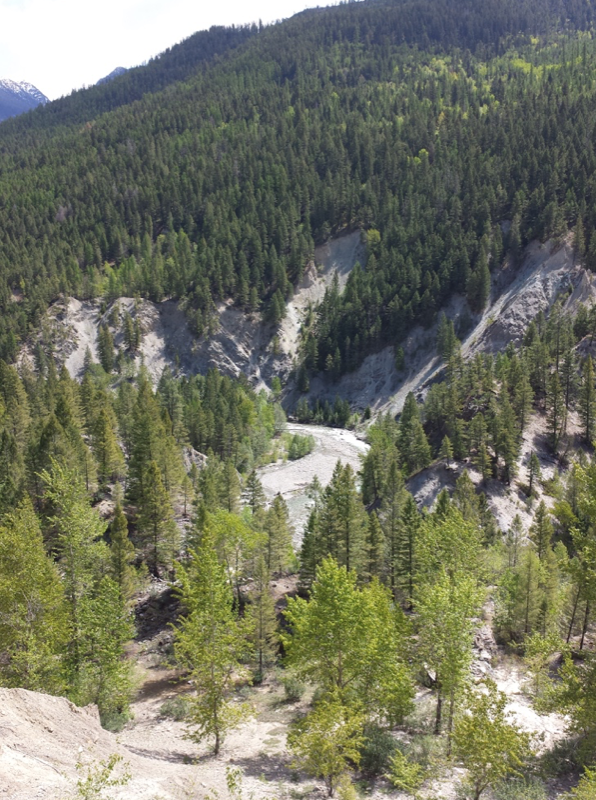Chinese Miners’ Burials in British Columbia
Robyn S. Lacy | September 10, 2019
Today I’d like to discuss the often overlooked contributions of the Chinese miners who traveled to British Columbia (BC) in the mid-late 19th century to seek their fortunes during the Fraser Valley and Wild Horse River Gold Rushes. It would be an understatement to say that Canadian history has been whitewashed by European and Euro-Canadian points of view, with examples such as a) the lack of understanding of the Japanese Internment Camps in BC, b) common knowledge that enslaved people escaped to Canada but not that enslaved people were also bought and sold here, and c) the brutal history of the Indigenous residential schools, recently illuminated for Canadians by artist Kent Monkman. Our history has been buried in continuous rhetoric that the most important contributions to the country are primarily white men, which of course could not be farther from the truth.
Wild Horse Creek, see from the cliffs near Fisherville. Photo by author 2015.
The Wild Horse River sits in the eastern region of the Kootenays, a mountainous portion of the modern province of British Columbia, near the modern town of Cranbrook. After gold was located within the soils and rock of the creek in 1864, a tent settlement popped up, and was called Fisherville after the first placer mine claim (Miller, 2002, p. 13). After only a few years, many white miners moved on, while the Chinese miners continued to arrive, eventually making up a large portion of the population.
It might not be surprising to know that white miners often did not honor the mining claims of the Chinese miners at Fisherville. As a result, Chinese miners were unable to mine a claim unless that claim had already been given up or exhausted by a while miner (Peters, 2016). However, the region was prosperous enough to support a population of over 5000 individuals (UBC Library ND), and the traces of their lives can still be seen in the woods at the original site...including Fisherville’s two burial grounds. One burial ground is located near the modern entrance to the area, complete with a historic plaque about the site. That burial space was reserved for white miners, although it appears the separation went both ways; while it is likely the Chinese miners were not permitted to bury their dead in the already established settler burial ground, the Chinese minors also had their own customs to follow and wished to create their own burial space to follow those customs – making the site historically unique as an example of Chinese overseas burial practices (Canada’s Historic Places, 2015). The Chinese burial ground is located on a sloped patch of earth, far from the European/American burial space and features the remains of an altar built onto the side of the hill.
The white settler burial ground at Fisherville, BC. Photo by author 2015.
Within this space, sectioned away from other parts of the community, the Chinese miners conducted their traditional burial practices until such a time that the bodies of those who died far from their homeland could be disinterred and sent back home to China. Whether they viewed these burials as temporary measures or permanent, the miners were observing their traditional customs in a foreign place, but it was a common practice during the period for remains to be sent back to China at a later date. Unfortunately, where there is opportunity, there is the opportunity for exploitation. While reputable organizations were created to offer this service to families, scam operations also cropped up to return bodies to China. In reality, they only sent the remains to Victoria to be dumped in a shed (Berman, 2016)!
During the mid-20th century, at least 50-75 years after the gold rushes had ended, the province paid for contractors to “exhume and repatriate the remains of Chinese nationals. But the Granite Creek Preservation Society has never been able to find records of that occurring, so it’s not entirely sure what happened to the bodies” (Meuse, 2017). The history of Chinese miners in British Columbia is poorly documented and researched, with little representation in the BC Archives (Berman, 2016).
Today, there are no longer bodies interred at the Chinese burial ground in Fisherville, and a sign states that the bodies were repatriated to China. Shallow divots in the ground indicate where graves once were, although the entire area is still treated as a burial space to this day, calling in the question of when does a grave stop existing? According to my own preliminary research on the topic, over 50% of the 281 anonymous individuals surveyed agreed that graves never stop being graves, even after the remains have completely decomposed or the bodies have been removed or relocated (Lacy, 2019). This view is reflected at Fisherville and many other Chinese burial sites associated with the Canadian ‘West’. Ultimately, the consensus is that the plots, although devoid of bodies, are still grave sites and should be remembered.
Signs on the trail through Fisherville, telling visitors about the Chinese burial ground on the hill in the background. Photo by author 2015.
Unfortunately, not everyone agrees with that point of view, or at least not that these particular burial plots should be respected the same as the white settler burials. The lack of respect is demonstrated in the vandalism to the burial site. Opportunists have been digging around the sacred ground for metal. In 2017, a news story broke on CBC that the Granite Creek Preservation Society suspected that metal detectorists were responsible for the new holes appearing in the Granite Creek Chinese burial ground, located in B.C.’s Similkameen region in the interior (Meuse, 2017). The article “Mysterious holes appear in ghost town cemetery in B.C. Interior” describes how Sterne, a member of the Preservation Society saw several individuals years before going over the area with metal detectors. When confronted they replied with “well, but this is only the Chinese section” (Meuse, 2017). Rather than searching for buried objects in the white settler burial grounds, the looters had chosen to dig in the Chinese burial area. The BC Heritage Conservation Act enacts protection over historical burial sites, stating that “Except as authorized by a permit . . . a person must not…damage, desecrate or alter a burial place that has historical or archaeological value or remove human remains or any heritage object from a burial place that has historical or archaeological value” (BC Heritage Conservation Act, Division 2, 12.1.2b). Even though the sites no longer contain human remains, for the most part, they are still protected as historic places under the Act, and as burial places with historical and archaeological value. The BC Cemetery and Funeral Services Act does not offer any insight on protection for historic burials, let alone historic Chinese burial grounds. These sites are protected, as all historic and archaeological sites in BC, by the Conservation Act, and digging through the graves today is a major disrespect to them and the role they played in the history of the region.
Like Fisherville, the town of Granite Creek had a huge Chinese population at the beginning of the 20th century. It is distressing that these burial grounds are still feeling the effects of colonialism particularly in how they are kept and thought about by the public. The Chinese settlers and miners were unable to be buried in the same ground as their white companions, nor were they often able to mine fresh claims, only being allowed to pick up where others had given up. Like many sites, the bodies at Granite Creek and Fisherville were reportedly exhumed and repatriated to China, but records are scarce, so we still don’t know exactly what happened to the remains.
Today the Chinese miners’ grave yard is at risk of looting, apparently more so than the white settler graves. We can only hope that their wishes were respected, and their bodies were returned to their native soil.
If you are ever visiting any of the forestry or mining settlements in British Columbia, stop by the Chinese burial grounds and pay a respectful visit to these unique spaces which hold the untold stories of so many individuals.
References
Berman, Sarah. 2016 Searching BC Ghost Towns in Search of Chinese Miners. Vice [website]. Available online at: https://www.vice.com/en_ca/article/aevan8/searching-bc-ghost-towns-for-traces-of-chinese-miners.
Canada’s Historic Places. 2015 Wildhorse Creek Historic Site. Canada’s Historic Places. Website: https://www.historicplaces.ca/en/rep-reg/place-lieu.aspx?id=20640.
Heritage BC. n.d. Wild Horse Creek / Fisherville. Heritage BC. Available online at: https://heritagebc.ca/chinese-canadian-location/wild-horse-creek-fisherville.
Lacy, Robyn S. 2019 When is a grave no longer a grave? Spade & the Grave [website]. February 27, 2019. Available online at: https://spadeandthegrave.com/2019/02/27/when-is-a-grave-no-longer-a-grave.
Meuse, Matt. 2017 Mysterious holes appear in ghost town cemetery in B.C. Interior. CBC News, British Columbia. May 25, 2017. Available online at: https://www.cbc.ca/news/canada/british-columbia/ghost-town-cemetery-1.4132366.
Miller, Naomi. 2002 Fort Steele: Gold Rush to Boom Town. Heritage House Publishing Company Ltd.:Surrey, BC.
Peters, Hammerson. 2016 Wild Horse Creek - Canada’s Forgotten Gold Rush. Mysteries of Canada [website]. Available online at: https://www.mysteriesofcanada.com/bc/tales-of-wild-horse-creek.
UBC Library. ND The Chinese Experience in British Columbia, 1850-1950: Mining. University of British Columbia Library [website]. Available online at: https://www.library.ubc.ca/chineseinbc/mining.html.
About the Author
Robyn S. Lacy is a historical archaeologist whose research focuses on burial landscapes in the seventeenth century, winter burial practices, and protective magic in mortuary contexts. She received her MA in Archaeology from Memorial University of Newfoundland in 2017 and has gone on to study historic standing buildings and gravestone conservation, while continuing her research on burial ground organization and landscapes.



